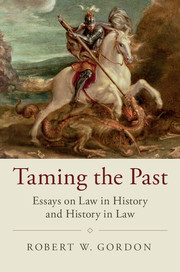Book contents
- Taming the Past
- Studies in Legal History
- Taming the Past
- Copyright page
- Dedication
- Contents
- Foreword
- Permissions
- Introduction
- Part I The Common Law Tradition in Legal Historiography
- Part II Legal Historians
- Part III History and Historicism in Legal History and Argument
- 10 Historicism in Legal Scholarship*
- 11 Critical Legal Histories*
- 12 The Past as Authority and as Social Critic: Stabilizing and Destabilizing Functions of History in Legal Argument*
- 13 Taming the Past: Histories of Liberal Society in American Legal Thought*
- 14 Originalism and Nostalgic Traditionalism
- 15 Undoing Historical Injustice*
- Index
- References
12 - The Past as Authority and as Social Critic: Stabilizing and Destabilizing Functions of History in Legal Argument*
from Part III - History and Historicism in Legal History and Argument
Published online by Cambridge University Press: 13 July 2017
- Taming the Past
- Studies in Legal History
- Taming the Past
- Copyright page
- Dedication
- Contents
- Foreword
- Permissions
- Introduction
- Part I The Common Law Tradition in Legal Historiography
- Part II Legal Historians
- Part III History and Historicism in Legal History and Argument
- 10 Historicism in Legal Scholarship*
- 11 Critical Legal Histories*
- 12 The Past as Authority and as Social Critic: Stabilizing and Destabilizing Functions of History in Legal Argument*
- 13 Taming the Past: Histories of Liberal Society in American Legal Thought*
- 14 Originalism and Nostalgic Traditionalism
- 15 Undoing Historical Injustice*
- Index
- References
Summary
[Unlike most of the other pieces in this collection, this one was written for an audience not of lawyers and legal scholars but of historians and social scientists. It resulted from an invitation to a conference organized in 1990 by the Program in Comparative Study in Social Transformations at the University of Michigan, a remarkable group of scholars from many different disciplines. Contributors to the conference were invited to speculate on the “turn” toward historical inquiry that seemed to be common to all these disciplines. This essay was written for that conference and the revised version of it published in Terrence J. McDonald (ed.), The Historic Turn in the Human Sciences (University of Michigan Press, 1996), 339–67.]
Information
- Type
- Chapter
- Information
- Taming the PastEssays on Law in History and History in Law, pp. 282 - 316Publisher: Cambridge University PressPrint publication year: 2017
